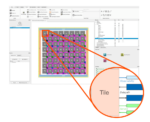A century ago, 391 San Antonio Road in Mountain View, California, housed an apricot-packing shed. Today, it’s marked by sculptures of diodes and a transistor, commemorating the 1956 founding of Shockley Semiconductor Laboratory—the birthplace of Silicon Valley. William Shockley, co-inventor of the transistor, aimed… Read More
Tag: ai inference
CEO Interview with Dr. Naveen Verma of EnCharge AI
Naveen Verma, Ph.D., is the CEO and Co-founder of EnCharge AI, the only company to have developed robust and scalable analog in-memory computing technology essential for advanced AI deployments, from edge to cloud. Dr. Verma co-founded EnCharge AI in 2022, building on six years of research and five generations of prototypes … Read More
Arteris Empowering Advances in Inference Accelerators
Systolic arrays, with their ability to highly parallelize matrix operations, are at the heart of many modern AI accelerators. Their regular structure is ideally suited to matrix/matrix multiplication, a repetitive sequence of row-by-column multiply-accumulate operations. But that regular structure is less than ideal … Read More
INTERVIEW: Bluespec RISC-V soft cores in Achronix FPGAs
Recently, a partnership between Achronix and Bluespec has been in the news. Bluespec RISC-V processors are available as soft cores in a Speedster®7t FPGA on Achronix’s VectorPath® PCIe development card or in a standalone Speedster7t FPGA. We spoke with executives from Achronix and Bluespec about the impetus for this effort … Read More
MIPI D-PHY IP brings images on-chip for AI inference
Edge AI inference is getting more and more attention as demand grows for AI processing across an increasing number of diverse applications, including those requiring low-power chips in a wide range of consumer and enterprise-class devices. Much of the focus has been on optimizing the neural network processing engine for these… Read More
Deep thinking on compute-in-memory in AI inference
Neural network models are advancing rapidly and becoming more complex. Application developers using these new models need faster AI inference but typically can’t afford more power, space, or cooling. Researchers have put forth various strategies in efforts to wring out more performance from AI inference architectures,… Read More
Area-optimized AI inference for cost-sensitive applications
Often, AI inference brings to mind more complex applications hungry for more processing power. At the other end of the spectrum, applications like home appliances and doorbell cameras can offer limited AI-enabled features but must be narrowly scoped to keep costs to a minimum. New area-optimized AI inference technology from… Read More
Semifore is Supplying Pain Relief for Some World-Changing Applications
In a recent post, I discussed how Samtec is fueling the AI revolution. In that post, I talked about how smart everything seems to be everywhere, changing the way we work, the way we think about our health and ultimately improving life on the planet. These are lofty statements, but the evidence is growing that the newest wave of applications… Read More
Ultra-efficient heterogeneous SoCs for Level 5 self-driving
The latest advanced driver-assistance systems (ADAS) like Mercedes’ Drive Pilot and Tesla’s FSD perform SAE Level 3 self-driving, with the driver ready to take back control if the vehicle calls for it. Reaching Level 5 – full, unconditional autonomy – means facing a new class of challenges unsolvable with existing technology… Read More
A clear VectorPath when AI inference models are uncertain
The chase to add artificial intelligence (AI) into many complex applications is surfacing a new trend. There’s a sense these applications need a lot of AI inference operations, but very few architects can say precisely what those operations will do. Self-driving may be the best example, where improved AI model research and discovery… Read More











